
|
 |
 |
Discoveries in the Deep Part 3 (back to Part 2) 1991 American Navy agrees to share with civilian scientists a fleet of deep exploratory craft, including robots and submersibles.
Soviet ship Yuzhmorgeologiya, which once spied on the submarines of the United States Navy, is hired by American government to do studies of deep ecology. Soviet Union ceases to exist. 1992 Scientists, after a large seabed survey, conclude that the deep may hold ten million species of life, far more than are known on land.
CIA director Robert Gates tells Russian President Boris Yeltsin that Glomar Explorer recovered remains of six Soviet sailors, who were subsequently buried at sea. American Navy adopts a new strategy in which fighting forces target shallow waters and regional conflicts, reducing the need for deep expertise. Businessmen hire an American Navy contractor to dive on Titanic for commercial salvage. 1993 Two American companies unveil laser cameras, formerly secret Navy tools for seeing long distances in the deep.
Japan begins testing Kaiko, the world's deepest-diving robot. French submersible Nautile dives on Titanic to recover artifacts. Ballard lowers Navy Jason robot in Celtic Sea to probe the deteriorating remains of Lusitania, torpedoed by Germany in 1915. 1994 American Navy agrees to share its attack submarines with civilian scientists for arctic studies. Navy turns over the Advanced Unmanned Search System, an early tetherless robot, to private industry. Shinkai 6500 sets an Atlantic depth record for a piloted vehicle, studying deep geology.
Nautile dives on Titanic to recover artifacts. United Nations Convention on the Law of the Sea goes into force. 1995 Kaiko dives to bottom of Challenger Deep, finding the icy darkness alive with small animals. Paul Tidwell arms himself with naval spinoffs and finds in Atlantic waters more than three miles down the lost Japanese submarine I-52, which sank in 1944 heavy with tons of gold.
Mir submersibles film Titanic for a Hollywood movie. American Navy releases seafloor gravity data, which civilian oceanographers turn into the first good public map of the global seabed. Civilians start broadcasting deep sounds across the Pacific and listening with Navy microphones for changes in travel time, seeking to measure global warming. 1996 Federal scientists listening to Navy microphones hear fury on the Gorda Ridge, prompting new studies of seabed volcanism.
Navy widens access to its deep microphones, prompting the development of private acoustic observatories meant to listen for volcanic eruptions and whale songs. The advanced robot Tiburon debuts at Packard's institute, ready to explore down to a depth of four kilometers, or two and a half miles. Nautile dives on the Titanic to film the shattered hulk and recover artifacts, including a large section of the liner's hull.
1997 American experts use the robot Odyssey to search the dark water off New Zealand for the giant squid, the greatest of the sea's legendary beasts.  This chronology is excerpted from:
This chronology is excerpted from:The Universe Below: Discovering the Secrets of the Deep Sea by William J. Broad, illustrated by Dimitry Schidlovsky Published by Simon & Schuster, 1997 Discoveries in the Abyss | Deep Sea Machines | Vents of the World Photos: (1) Susan Lewis; (2,7,15) IFREMER/Violaine Martin; (3) ©1996 Norbert Wu; (4,8,17,19) Shirshov Institute of Oceanology; (5) Dan Fornari, Woods Hole Oceanographic Institution; (6,9) ©Woods Hole Oceanographic Institution; (10,18) Visuals Unlimited/©WHOI/J. Edmond; (11) Copyright ©1998 Harbor Branch Oceanographic Institution, Inc.; (12) Kim Juniper; (13) Tim Shank, Rutgers University; (14) Ralph White; (16) Chris Keeley, University of New Hampshire; (20) ©1998 Norbert Wu. The Mission | Life in the Abyss | The Last Frontier | Dispatches E-mail | Resources | Table of Contents | Abyss Home Editor's Picks | Previous Sites | Join Us/E-mail | TV/Web Schedule About NOVA | Teachers | Site Map | Shop | Jobs | Search | To print PBS Online | NOVA Online | WGBH © | Updated October 2000 |
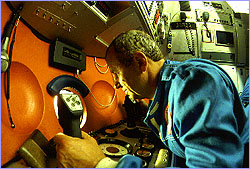 Mir submersible investigates the seafloor.
Mir submersible investigates the seafloor.
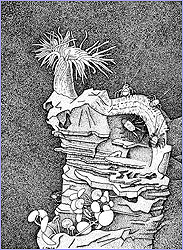 A deep-sea anemone crowns a lava pillar.
A deep-sea anemone crowns a lava pillar.
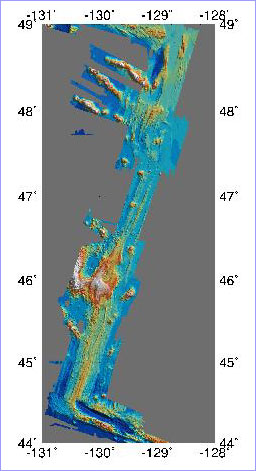 Map of the Juan de Fuca Ridge.
Map of the Juan de Fuca Ridge.
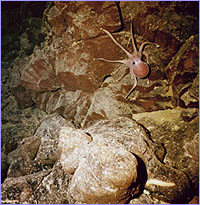 Octopus clambers across the sea bottom.
Octopus clambers across the sea bottom.
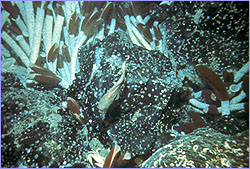 A tubeworm community.
A tubeworm community.
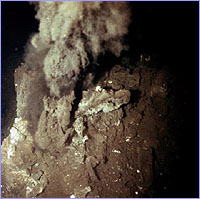 Billowing 'smoke' from a deep-sea vent.
Billowing 'smoke' from a deep-sea vent.
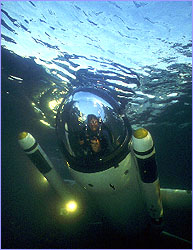 'Deep Flight' on a mission.
'Deep Flight' on a mission.